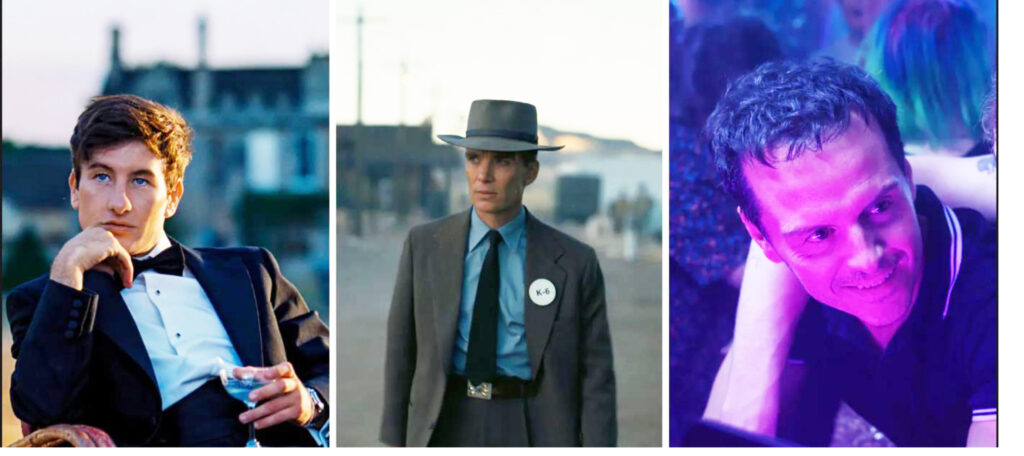They’ve come a long way from Barry Fitzgerald’s irascible priest in 1944’s Going My Way. Who? Irish actors, who seem to be challenging Australians as the dominant Anglo group now quietly conquering Hollywood.
Aside from long-established transplant stars like Liam Neeson and Colin Farrell (and, representing the distaff side, actress Saoirse Ronan), we now have Cillian Murphy as the Oscar favorite for Oppenheimer. This follows Murphy’s Golden Globe win of a few weeks ago, where he was up against two other mates, Barry Keoghan for Saltburn and Andrew Scott for All of Us Strangers.

Keoghan, in fact, was nominated for an Academy Award for Best Supporting Actor in 2023 for The Banshees of Inisherin, while Scott’s co-star in Strangers, fellow Irishman Paul Mescal, was a Best Actor nominee for Aftersun, also in 2023. The Academy Award for Best Short Subject film at the 2023 show likewise went to an Irish filmmaking crew.
Why this sudden success?
Obviously, like their immigrant Irish predecessors over a century ago in America, one factor is their facility with the English language. These actors are either allowed to use their own brogues when permitted but can also alter them for British or American roles.
(Or even bogus accents: Mescal stars in the upcoming sequel to Gladiator, perpetuating the Hollywood Lie that Romans spoke with British cadences).
And it’s not just sheer dumb luck. As evidence by the recognition above, these guys are seriously talented. Note the complexity of the roles they’ve been allowed to inhabit: action heroes (Neeson), loveable rogues (Ferrell), brilliant scientists (Murphy), sensitive gay men (Scott), sensitive dads (Mescal), and educated nerds (Keoghan in Saltburn, the opposite of his village idiot role in Inisherin, a character who was still treated with admirable empathy).
Have Italian actors—those from Italy, not our motley and misguided Italian American ones—ever achieved such success?
Actually, one did, and quite spectacularly: Rudolph Valentino. An immigrant from Castellaneta, Puglia, he achieved great success during the Silent Era playing The Sheik, setting the template for the Latin Lover still with us today. Valentino died in 1926, however, at the age of 31, thus depriving him of the chance to cross over into talking films.
Actors who came over from Italy during the next few decades (1930s-1960s) either became well-known character actors like Eduardo Ciannelli or inheritors of Valentino’s “gigolo” image (Rosanno Brazzi). But, with rare exceptions like the Malta-born Joseph Calleia, who played Enrico Fermi in the 1947 film The End of the World, images of native-born Italians in American movies never moved beyond gangsters, waiters or new immigrants.
(This also refers to animated cartoons: Don’t forget the over-the-top Italian restauranteurs in Disney’s Lady and the Tramp).
As for actors like Marcello Mastroianni, Alberto Sordi and Roberto Begnini? Admired by Americans, they pretty much stayed in Italy, though Mastroianni did make a forgettable 1992 American film called Used People, playing a variation on the Italian Lothario (seducer). And when Vittorio Gassman played an Italian-born father-of-the-groom in 1978’s A Wedding, he was viewed with suspicion by the wealthy WASP family-of-the-bride. He was too lower-class.
To circle back to my main subject: What about the younger generation of actors in Italy, akin to these young Irish thespians? Some, like Antonio Sabato Jr in the 1990s (born in Rome), assimilated very quickly and became Americanized. In keeping with the Valentino tradition, though, Sabato was promoted as a modern update of the Latin Lover. Popular Italian actors who have made appearances in American movies (such as Raoul Bova in 2003’s Under the Tuscan Sun) fulfilled the same role.
I guess it’s better than portraying them as puppy gangsters, though current films like Mafia Mamma and The Equalizer III certainly have no compunction hiring local Italian actors to fulfill those crude stereotypes ad nauseum.
To be fair, Hollywood treats Italian women like visual love objects, as well: Sofia Loren, Gina Lollobrigida, Claudia Cardinale and Monica Bellucci were all viewed as breath-taking beauties (which they are). But they, like their male counterparts, also had much more to offer. Loren’s 1961 Oscar win for Two Women was for an Italian film, not a Hollywood one. The one exception was Anna Magnani’s triumph in The Rose Tattoo, both the play and the movie. She had the backing of a powerful ally: playwright Tennessee Williams, who wrote the role specifically for her. He saw the talent beneath her plain looks.
So why do young Italian actors have such a hard time breaking through in Hollywood—the language barrier? the stereotyping? the reluctance to indulge in Hollywood weirdness?
(Example of the latter: In the final scene of Saltburn, Keoghan does a five minute, fully nude dance solo in an empty mansion, his member acting like a metronome. Faith and Gomorrah!).
One bright spot, though: In the 2015 film Brooklyn, set in the 1950s, a young Irish immigrant (Saoirse Ronan) has to choose between an Irish fella back home (Jim Farrell) and an Italian American boy from the title city (Tony Fiorello). Old World Italy wins out. Score one for us! -BDC.

Recent Comments